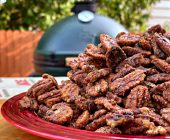What could possibly make prime rib more epic? How about adding that big, bad, bold charcoal flavor of the Big Green Egg?
How To Grill Bone-In Prime Rib On A Big Green Egg Layer in some wood chunks and you have an even better recipe for mouthwatering Prime Rib. This recipe delivers amazing results thanks to the Ultimate Cooking Experience.Print Recipe: Bone In Prime Rib - On the Big Green Egg
Yield: 1 Prime Rib Prep time: 25 Minutes Prep, 12-16 hours of Wrap Time Cook time: 1 ¾ - 2 ½ hours of cook time, plus 15-20 minute rest time
Ingredients:
-
7.5 lb - Prime Rib, Bone In
-
Taste - Rub a Dub, 5280 Culinary
-
Taste - Island Boys Coffee, 5280 Culinary
Prepping Big Green Egg
-
Pre Heat your Big Green Egg to 200˚ and (if desired) load with your preferred smoking wood chunks (Layer in the wood chunks to create an even sustained smoke flavor)
-
If using EGGgenius, add it now, setup ambient probe and adjust temp to 350˚
-
Add the ConvEGGtor legs up, ADD a convEGGtor drip tray and then place grill grate on top of convEGGtor
-
Close the lid and cook at 350˚ until desired doneness is reached (see chart below for approx. cooking times and doneness levels)
Chef’s Tips – Today’s video we cooked the rib to 125˚, rested for 15 minutes and sliced open for a nice medium doneness
Cooking Directions:
-
Remove from the cryo-vac package and put onto a large cookie sheet pan, allow to drain any juices and warm up at room temperature for 20 minutes
-
Starting at the tail, bone side of the Ribeye Roast, cut the bone along the ribs, between the meat and ribs, to the back side, separating the bones from the meat
-
Rub the entire prime rib with a light coat of oil or bacon fat
-
Next liberally season on all sides (and under the bone) with our Prime Rib Rub-a-Dub, Chef’s Rub-A-Dub, Island Boys Coffee Rub or a 50/50 blend of Rub-A-Dub and Island Boys.
-
Allow the rub to sit on the Prime Rib for another 20 minutes
-
Return the bones to the bottom side and using butcher twine, secure in 3 areas by tying the bones to the meat
-
Wrap in plastic wrap and place on a cookie sheet pan and into the fridge. I suggest leaving wrapped for 12-16 hours
-
Place the Prime Rib on the grill grate to catch the drippings. Ribs or Rib Side Down. Fat Side Up.
-
Add any additional seasoning to the top of the prime rib if desired
-
Add any bacon fat or butter to the top of the prime rib if desired
-
Do not cover the prime rib during the cooking process
-
Close the lid and sear at 350˚ for 40 minutes, then adjust the Big Green Egg down to 325˚ and cook until desired doneness is reached (see chart below for approx. cooking times and doneness levels)
-
Remove from the Big Green Egg with time to allow for resting and carry over.
CHEF TIP: I remove my prime rib about 10-12 degrees before my desired temp, this allows carry over and resting
Prime Rib Roasting Timetable:
Keep in mind smoker and grill temps may vary, so use a good quality digital thermometer to best judge doneness.
Weight with Bones |
Approximate Cooking Times |
3 Ribs – 7-8 Pounds4 Ribs – 9-11 Pounds5 Ribs – 12-13 Pounds6 Ribs – 14-16 Pounds7 Ribs – 16 Pounds and UP |
1 ½ - 1 ¾ Hours plus resting time1 ¾ - 2 ½ Hours plus resting time2 ½ - 3 Hours plus resting time3 – 3 ½ Hours plus resting time3 ½ - 4 ½ Hours plus resting |
Other Tips and Suggestions
Beef will continue to Carry Over cook. Once removed from the oven it will continue to cook another 10-12 degrees in 20 minutes of resting. Be sure to pull slightly under desired doneness to allow for carry over cooking. Rest 15-20 minutes total.
DONENESS |
TEMP |
COLOR |
MOISTURE LEVEL |
Rare |
80-100 |
Blueish – Deep Red |
Highest |
Medium Rare |
125 - 135 |
Red with slight pink |
High |
Medium |
140 - 145 |
Pink with slight brown |
Medium |
Medium Well |
150 - 155 |
Mostly Brown |
Low |
Well Done |
160 and above |
Brown / Grey |
Lowest |
Prime Rib or Beef?
First, let’s start off with the definition of Prime Rib. What is Prime Rib? Is it Prime?
A standing rib roast, also known as prime rib, is a cut of beef from the primal rib, one of the nine primal cuts of beef. While the entire rib section comprises ribs six through 12, a standing rib roast may contain anywhere from two to seven ribs.
PRIME in the term PRIME RIB means its one of the 9 PRIME Cuts of meat. (Chuck, Rib, Short Loin, Sirloin, Round, Brisket, Shank, Plate and Flank)
Depending on the budget you have for this holiday or celebration treat there is a quality level to meat your needs. We find that by placing our orders before the holiday season starts, we are able to get better pricing and then pickup as we need. Check with your local butcher, grocery store, grocery club or meat counter and see if this is something they can offer. Prices do increase during high demand seasons and holidays.
Top 5 Quality Grades
-
U.S. Prime – Highest in quality and Moderately Abundant Marbling, limited supply.
-
U.S. Choice – Certified Angus Beef – This grade represents the upper 2/3 of the Choice range. Higher quality and Moderate Marbling
-
U.S. Choice – High quality and Modest Marbling
-
U.S. Select – Medium quality and Slight Marbling
-
U.S. Standard – Lower quality and Trace Marbling
Selecting the Perfect Prime Rib
I am having 6 people over, how much should I buy? Do I need to buy it with the rib bones on?
A good rule of thumb is to plan on 1 bone per 2 people. That can equate to about 10 oz of cooked prime rib per person. Keep in mind there will be a small amount of shrink while cooking, so buy a tiny bit extra to ensure you have some leftovers for those shaved prime rib sandwiches the next day.
Bone or no bone? While the bones do add a great flavor, it’s not necessary to cook a bone in rib roast. If cooking a boneless roast please follow the same methods as above and reduce total cooking time by 20-30 minutes depending on cooking tool used.
When choosing a size, we don’t recommend buying anything under a 2 bone portion, as this is more of a thick steak style cut and will be difficult to roast and keep from drying out.
For more helpful tips and advice, visit a Neighborhood Ace or Ace Hardware's Tips & Advice online


